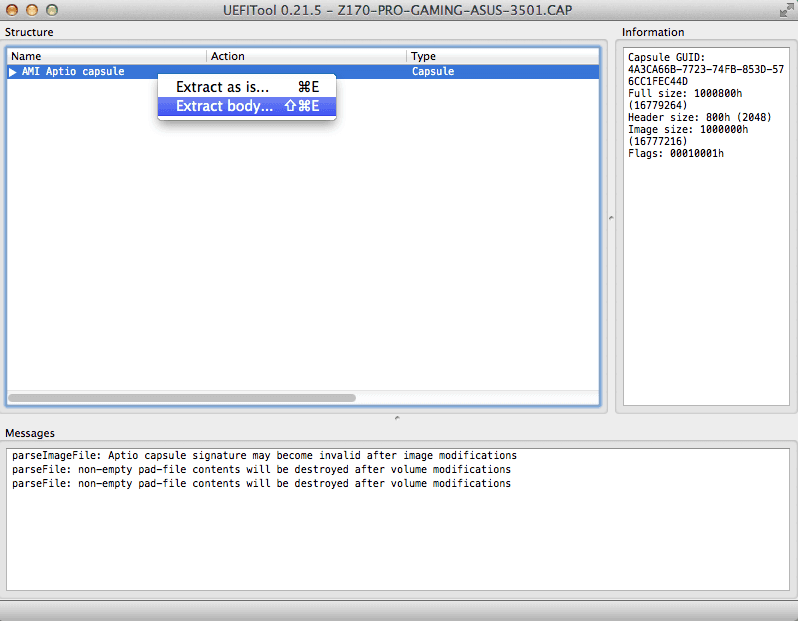


u, -unknowns When generating also print unknowns. d, -flash The input file is a flash descriptor. b, -brute The input file is a blob, search for firmware volume c, -capsule The input file is a firmware capsule, do not search. Output GUIDs for files, optionally write GUID structure file. This project will try to keep up-to-date with popular vendor GUIDs automatically. Using the -g LABEL the script will generate a Python dictionary-formatted output. There is an included script to generate additional GUID labels to import into IDA Python using Snare’s plugins. At the moment this is not-yet-scriptable. Note: when injecting into a firmware file the user will be prompted for which section to replace. f, -ff Inject payload into firmware file. c, -capsule The input file is a firmware capsule. Search a file for UEFI firmware volumes, parse and output. Usage: fv_injector.py -injection INJECTION Injection or GUID replacement (no addition/subtraction yet) can be performed on sections within a UEFI firmware file, or on UEFI firmware files within a firmware filesystem. Firmware descriptor generation using the parsed input volumes.Complete UEFI Firmware volume object hierarchy display.Tiano/EFI, and native LZMA (7z) compression.Intel ME modules parsing (ME, TXE, etc).UEFI Firmware Volumes, Capsules, FileSystems, Files, Sections parsing.$ uefi-firmware-parser -superbrute ~/firmware/970E32_1.40 The later performs a byte-by-byte type checker. If the -test option fails to identify the type, or calls it unknown, try to use the -b or -superbrute option.
Uefitool linux how to#
The firmware-type checker will decide how to best parse the file. If parsing and searching for internals in a shell the -echo option will print the input filename before parsing. If you need to parse and extract a large number of firmware files check out the -O option to auto-generate an output folder per file. To test a file or directory of files: $ uefi-firmware-parser -test ~/firmware/* test Test file parsing, output name/success. Generate a FDF, implies extraction (volumes only)

e, -extract Extract all files/sections/volumes. c, -echo Echo the filename before parsing or extracting. O, -outputfolder Dump firmware objects to a folder based on filename superbrute The input is a blob and may contain any sort of

b, -brute The input is a blob and may contain FV headers. h, -help show this help message and exit Parse, and optionally output, details and data on UEFI-related firmware. dump() walk the hierarchy and write each to a fileĪ Python script is installed uefi-firmware-parser $ uefi-firmware-parser -h.showinfo() print a hierarchy of information about the structure.process() performs parsing work and returns a True or False.In all cases there are abstract methods implemented: There are several classes within the uefi, pfs, me, and flash packages that accept file contents in their constructor. Parser = uefi_firmware.AutoParser(file_content) With open('/path/to/firmware.rom', 'r') as fh: The simplest way to use the module to detect or parse firmware is through the AutoParser class. pefile is optional, and may be used for additional parsing.The compression/decompression features will use the python headers and gcc.Python development headers, usually found in the python-dev package.
Uefitool linux install#
To install from Github, checkout this repo and use: $ sudo python. This module is included within PyPy as uefi_firmware $ sudo pip install uefi_firmware Please use the example scripts for parsing tutorials. This includes parsing modules for BIOS, OptionROM, Intel ME and other formats too. The UEFI firmware parser is a simple module and set of scripts for parsing, extracting, and recreating UEFI firmware volumes.


 0 kommentar(er)
0 kommentar(er)
